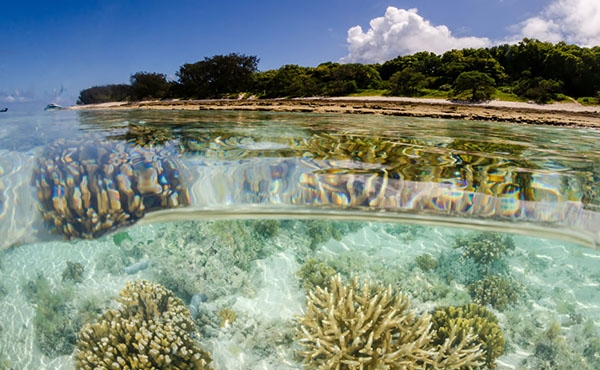Carbon dioxide concentrations in our atmosphere, and consequently our oceans, are increasing as a result of anthropogenic activities.536 When carbon dioxide is absorbed by seawater a series of reactions occur which affect ocean acidity and carbonate chemistry (reducing the availability of carbonate).540 Collectively these processes are referred to as ocean acidification.
Over the last 140 years, the average pH of surface waters around Australia and globally is estimated to have declined by about 0.12 units, which is equivalent to a 30 per cent increase in acidity.540 The rate of decline in ocean pH has been particularly rapid in recent decades.540 Alongside changes in pH, saturation levels of both aragonite and calcite (forms of calcium carbonate crystal) are decreasing in Australia’s oceans.359
In line with global and Australian trends, progressively increasing concentrations of carbon dioxide and decreasing values of pH and aragonite saturation were recorded within the Region over the 10 years from 2009 to 2019.739 Ocean acidification has significant implications for marine life across the Region, affecting growth,338 reproduction,341 behaviour 339,340 and physiology 740 across a wide variety of species.741,742
Calcifying species, those which produce calcium carbonate skeletons and shells, such as corals, molluscs, crustaceans and coralline algae,281,743,744 are considered particularly vulnerable to acidification. As carbonate concentrations decrease, calcification becomes more challenging and the tendency for calcium carbonate crystals to dissolve increases,745 leading to overall decreases in calcification on coral reef ecosystems.746,747,748,749
Seawater chemistry experiments at a natural coral reef site in the southern Great Barrier Reef demonstrate that ocean acidification may already be affecting the growth of coral reefs in the Region.748,750 In the north, decreases in net ecosystem calcification and increased dissolution observed on reef sites at Lizard Island between 2008 and 2016 have also been attributed in part to ocean acidification.751 Changes in densities of crustose coralline algae, macroalgae and coral juveniles in coastal areas of the Great Barrier Reef have been linked to reduced aragonite saturation.281 Skeletal density of coral is susceptible to changes in seawater carbonate concentrations and warming,752 and researchers are working to untangle the details of these effects.753,754,755,756
Calcium carbonate sediments in lagoons and intereefal areas are likely to be even more sensitive to dissolution under increasing acidity than living calcifiers, due to various physical properties of sands, such as grain size and surface area.757,758 Sea cucumbers (and potentially other deposit feeders) speed up the dissolution of calcium carbonate by ingesting lagoon sediments, a process that may contribute to localised buffering of ocean acidification.750,759
Abundance of calcifying zooplankton has been observed to reflect seasonal patterns in aragonite saturation within the Region. This may be a direct consequence of seasonal changes but could also suggest that calcifiers are sensitive to the changes in aragonite saturation at the values already being observed.359
Ocean pH around Australia has declined over the past century, particularly rapidly since the 1980s,540 and ecosystem impacts attributed to ocean acidification have been reported from within the Region. Impacts are expected to increase under predicted future scenarios: models suggest that surface ocean pH may decrease by a further 0.1 to 0.4 units and dissolved carbonate ion concentration by up to 50 per cent by 2100.359,741 On a global scale, coral reefs could shift towards net dissolution during this century.746,749,760
Ocean pH has declined within the Region, in line with global and Australian trends. It is likely that the rate of decline has increased in recent decades, driven by progressive ocean uptake of carbon dioxide due to increasing emissions. Ocean acidification has significant implications for coral reef ecosystems.


